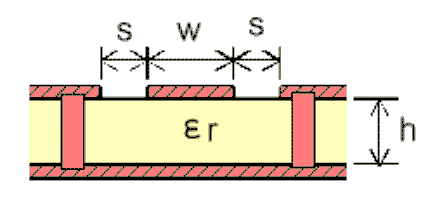ZHCSM61C November 2014 – September 2020 CC3200MOD
PRODUCTION DATA
- 1 特性
- 2 应用
- 3 说明
- 4 Functional Block Diagrams
- 5 Revision History
- 6 Device Comparison
- 7 Terminal Configuration and Functions
-
8 Specifications
- 8.1 Absolute Maximum Ratings
- 8.2 ESD Ratings
- 8.3 Power-On Hours (POH)
- 8.4 Recommended Operating Conditions
- 8.5 Power Consumption Summary
- 8.6 Brownout and Blackout Conditions
- 8.7 WLAN RF Characteristics
- 8.8 Reset Requirement
- 8.9 Thermal Resistance Characteristics for MOB and MON Packages
- 8.10 Timing and Switching Characteristics
- 9 Detailed Description
- 10Applications, Implementation, and Layout
- 11Environmental Requirements and Specifications
- 12Device and Documentation Support
- 13Mechanical, Packaging, and Orderable Information
请参考 PDF 数据表获取器件具体的封装图。
机械数据 (封装 | 引脚)
- MOB|63
散热焊盘机械数据 (封装 | 引脚)
10.5.3 Transmission Line
The RF signal from the device is routed to the antenna using a Coplanar Waveguide with ground (CPW-G) structure. The CPW-G structure offers the maximum isolation across filter gap and the best possible shielding to the RF lines. In addition to the ground on the L1 layer, placing GND vias along the line also provides additional shielding.
Figure 10-3 shows the coplanar waveguide.
 Figure 10-3 Coplanar Waveguide (Cross Section) With GND and Via Stitching
Figure 10-3 Coplanar Waveguide (Cross Section) With GND and Via Stitching
Figure 10-4 shows the top view of the CPW with GND.
 Figure 10-4 CPW With GND (Top View)
Figure 10-4 CPW With GND (Top View)Table 10-4 and Table 10-5 provide the recommended values for 2-layer boards and 4-layer boards, respectively.
Table 10-4 Recommended PCB Values for 2-Layer Boards (L1 to L2 = 40 mils)(1)
| PARAMETER | VALUE | UNIT |
|---|---|---|
| W | 35 | mils |
| S | 6 | mils |
| H | 40 | mils |
| Er (FR-4 substrate) | 3.9 |
(1) The CC3200MOD Launchpad uses a 4 layer stack-up to route other components on the board. Customer can choose a two-layer stack-up based on the values shown here.
Table 10-5 Recommended PCB Values for 4-Layer Boards (L1 to L2 = 10 mils)
| PARAMETER | VALUE | UNITS |
|---|---|---|
| W | 20 | mils |
| S | 18 | mils |
| H | 10 | mils |
| Er (FR-4 substrate) | 4 |